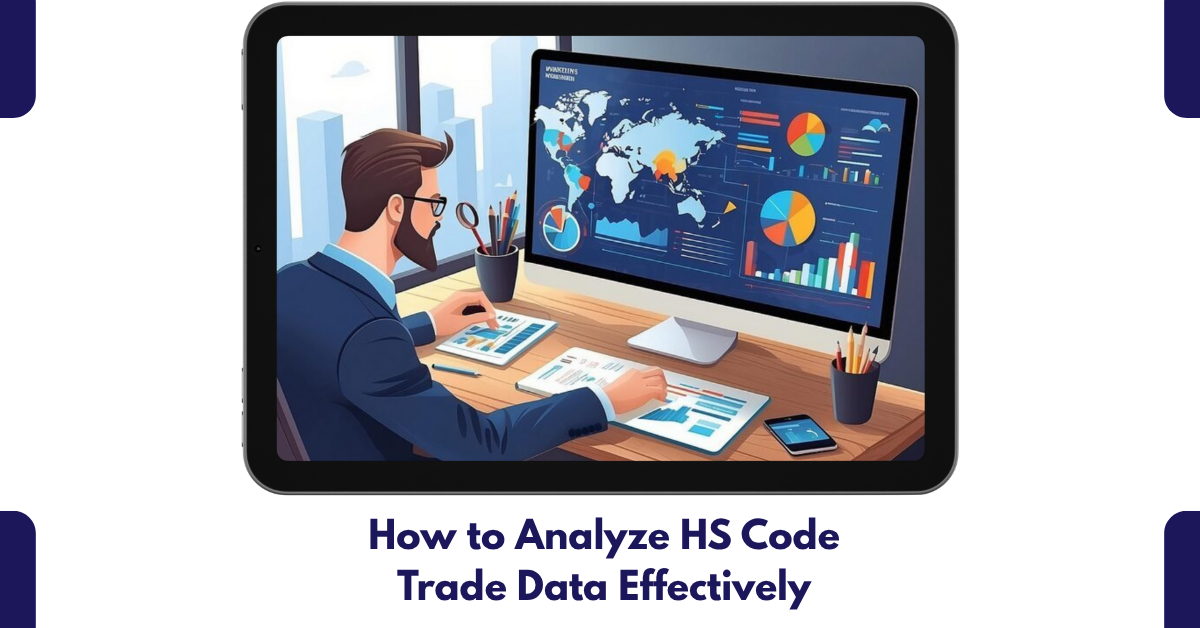The Power Behind Trade Intelligence
Every product exchanged across borders has a hidden code—a series of numbers identifying the product, dictating tariffs, compliance, and international trade flows. That is the HS code trade data, an international system that empowers business, policymakers, and researchers alike with insights. In a world of thin margins, brutal competition, and information being the supreme ruler, the power to dissect H.S code data is not a luxury—it’s revolutionizing. From discovering untapped markets to analyzing rivals’ supply chains, HS data brings insights in a world that’s so often shrouded in doubt.
Global trade depends on detail, and those who crack trade codes successfully are ahead of everyone else. It is not simply a question of numbers. It is a matter of seeing trends, forecasting possibilities, and reducing risks. From finding raw materials, expanding into a new market, or maximizing current operations, successful trade code analysis is the key to wiser choices.
Why HS Code Trade Data Matters
The Harmonized System (HS) is more than a management device; it’s the foundation of global trade classification. Every code signifies a product with accuracy. Examining the data shows not only the amount of merchandise crossing borders but the economic beat of industries as a whole.
For businesses, access to HS code trade data India offers a map of import and export dynamics. Decision-makers are able to benchmark competitors, detect supply chain weaknesses, and assess pricing trends. Policymakers use the same information to develop regulations, negotiate trade agreements, and monitor compliance.
More importantly, the power to interpret data in a meaningful way turns raw numbers into strategic capital. What appears as a map of codes can, in fact, unlock movement in demand, hidden market spaces, or even geopolitical disruptions that impact supply chains.
Grabbing Attention with Tangible Insights
Picture having the ability to look at which nations are raising imports of drugs, or seeing where exports of electronics are dropping before rivals catch on. Import export statistics by nation make it feasible. When deciphered properly, HS data does not only reveal what is taking place but also why.
The availability of free import export data online has made global trade intelligence democratic. Large, not just conglomerate, businesses are no longer the only ones to evaluate opportunities and risks to a similar degree of precision. With India imports and exports data, small businesses are able to calculate demand patterns, bargain more effectively with vendors, and pursue international alliances that were previously unthinkable.
Even comprehensive sources like DGFT Import Export data enable companies to incorporate official trade statistics into strategic planning. By correlating policy releases with data flows, firms can predict regulatory effects more effectively.
Tools and Techniques
HS code trade data analysis effectively needs a systematic approach. The issue is not gathering data but converting it into usable intelligence. Here are essential methods:
1. Classification Precision
Each HS code has to be correctly interpreted. Skewed analysis results from misclassification. Whether one is going through HS code trade data PDF reports or online data, classification accuracy assures reliable insights.
2. Comparative Analysis
Through comparison of free import export data with importer name, companies can compare competitors, spot sourcing approaches, and discover new players. For instance, observing an unexpected surge in imports from one country may signal cost leverage or changing supplier loyalties.
3. Time-Series Evaluation
Monitoring India exports and imports statistics for months or years exposes long-term trends. Are the exports of textiles falling in line with overseas competition? Is there a seasonal peak in electronics imports? Historical research exposes cycles beneath the radar in short-term appraisals.
4. Market Segmentation
With import export data by country, companies can chart target geographies, find markets with emerging demand, and redefine supply chains accordingly. This is especially worthwhile for exporters looking to expand into newly opened markets.
5. Financial Linkages
Combining import export data Bank with trade flows offers richer financial intelligence. It enables measurement of payment tendencies, credit exposures, and cross-border transaction patterns—critical for companies considering partnerships or investment ventures.
Opportunities Hidden in Data
Trade statistics, when carefully analyzed, tell unseen stories of international trade. Companies that excel at HS analysis not only spot opportunities for expansion but also reduce risks.
Market Expansion: Companies utilizing HS code trade data India are able to identify areas where imports of their product segments are on the rise, which allows for focused marketing campaigns.
Competitive Benchmarking: By analyzing free import export data with importer name, companies can monitor competitor shipments, gauge market share, and optimize strategies.
Risk Mitigation: Tracking DGFT Import Export data enables companies to foresee policy changes in trade and realign operations prior to disruptions.
Cost Optimization: Historical India import and export data offers hints at price volatility, enabling companies to negotiate improved contracts.
The aspiration comes from recognizing that each recorded shipment is a cue. Each trend is a potential waiting to be seized. Those with vision beyond the codes and figures turn data into a navigating compass for the world.
Steps Toward Effective Analysis
Unlocking the genuine power of HS code trade data takes intentional steps. Here’s a workable guide:
Step 1: Access Reliable Sources
Start with reliable sites—genuine portals providing DGFT Import Export data, free import export data online, or downloadable HS code trade data PDFs. Cross-check with several sources to verify authenticity.
Step 2: Define Business Objectives
What for? Entry into the market, supplier sourcing, or risk analysis? Specific goals define the manner in which the data will be sliced and analyzed.
Step 3: Use Analytical Tools
Use software with high capacity to handle large datasets. Excel can do for small projects, but sophisticated business intelligence platforms reveal more insights.
Step 4: Segment and Compare
Segregate import export data by country and compare on different timelines. Utilize filters on product categories, shipment quantities, and regions in order to find patterns.
Step 5: Integrate Financial and Policy Layers
Fuse trade flows with import export data Bank and government announcements. This integrated view links commerce with capital and compliance.
Step 6: Translate Findings into Strategy
The ultimate aim is action. Whether it’s entering new markets, changing supply chains, or renegotiating supplier terms, data-driven decisions guarantee competitive edge.
Conclusion: The Future of Trade Intelligence
In today’s speedy global business, delaying action in anticipation of instinct or old news is no longer an option. Those able to decipher and interpret HS code trade information well will be at the forefront of finding new markets, staying out of trouble, and minimizing costs.
From HS code trade data India to import export data by country, from free import export data online to DGFT Import Export data, all datasets are a chance hidden in numbers. With strategic use of these insights, companies not only engage in trade—they help determine its future.
The capability to convert raw figures into useful intelligence determines the distinction between firms that succeed and firms that dominate. The decision is in how well trade information is examined currently to obtain future growth.
FAQs: HS Code Trade Data
Q1. What is an HS code in trade data?
HS code (Harmonized System code) is an international classification system that assigns unique numbers to products for import-export tracking.
Q2. Why is HS code trade data important?
It allows businesses to analyze product-specific trade flows, identify top importing/exporting countries, and ensure compliance with customs regulations.
Q3. How can I access HS code trade data?
You can access it through government customs authorities, the World Customs Organization (WCO), or private trade database providers.
Q4. Who uses HS code trade data?
Exporters, importers, customs brokers, policymakers, and researchers use it for market analysis, compliance, and strategic planning.
Q5. Is HS code trade data updated regularly?
Yes, reputed providers update HS code-level data frequently using customs and shipping documentation.



